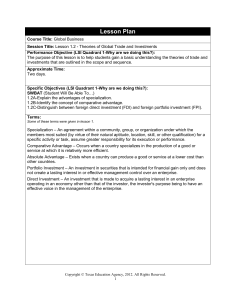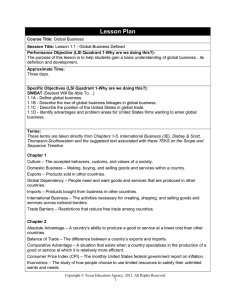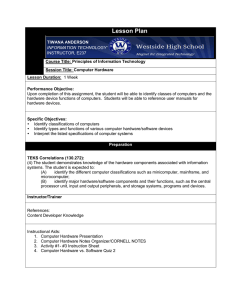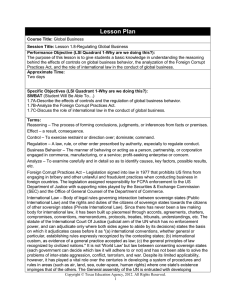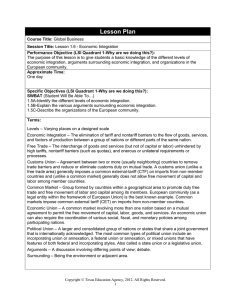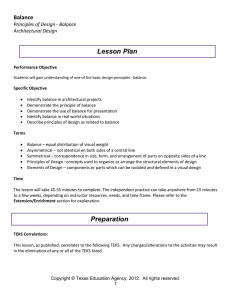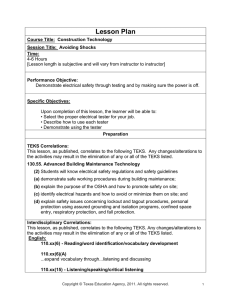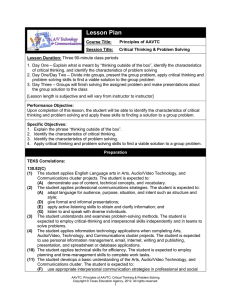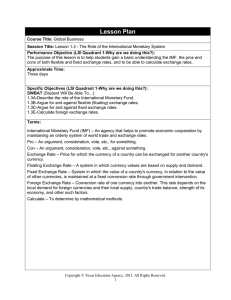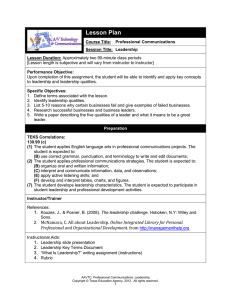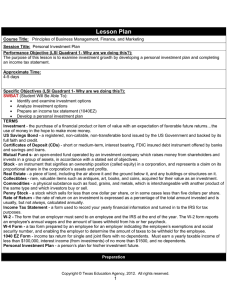Lesson Plan
advertisement
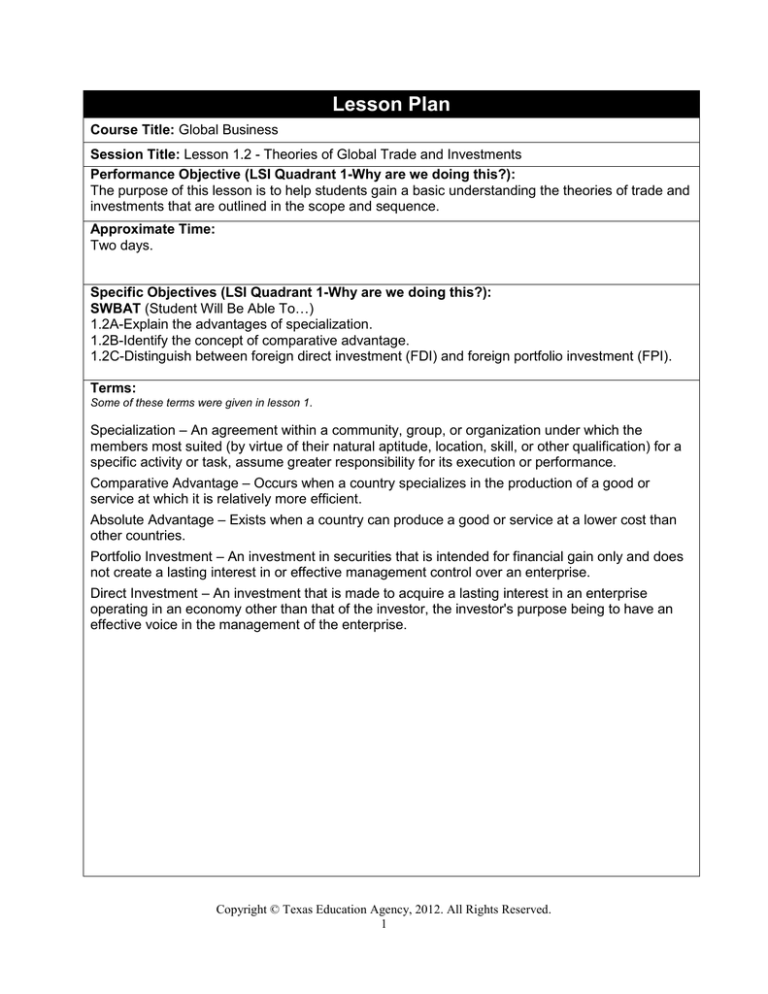
Lesson Plan Course Title: Global Business Session Title: Lesson 1.2 - Theories of Global Trade and Investments Performance Objective (LSI Quadrant 1-Why are we doing this?): The purpose of this lesson is to help students gain a basic understanding the theories of trade and investments that are outlined in the scope and sequence. Approximate Time: Two days. Specific Objectives (LSI Quadrant 1-Why are we doing this?): SWBAT (Student Will Be Able To…) 1.2A-Explain the advantages of specialization. 1.2B-Identify the concept of comparative advantage. 1.2C-Distinguish between foreign direct investment (FDI) and foreign portfolio investment (FPI). Terms: Some of these terms were given in lesson 1. Specialization – An agreement within a community, group, or organization under which the members most suited (by virtue of their natural aptitude, location, skill, or other qualification) for a specific activity or task, assume greater responsibility for its execution or performance. Comparative Advantage – Occurs when a country specializes in the production of a good or service at which it is relatively more efficient. Absolute Advantage – Exists when a country can produce a good or service at a lower cost than other countries. Portfolio Investment – An investment in securities that is intended for financial gain only and does not create a lasting interest in or effective management control over an enterprise. Direct Investment – An investment that is made to acquire a lasting interest in an enterprise operating in an economy other than that of the investor, the investor's purpose being to have an effective voice in the management of the enterprise. Copyright © Texas Education Agency, 2012. All Rights Reserved. 1 Preparation TEKS Correlations: This lesson, as published, correlates to the following TEKS. Any changes/alterations to the activities may result in the elimination of any or all of the TEKS listed. 1.2 The student analyzes the theories of global trade and investments. (A) Explain the advantages of specialization. (B) Identify the concept of comparative advantage. (C) Distinguish between portfolio investment (FPI) and direct investment (FDI). Interdisciplinary Correlations: English-English 1 110.31(b)(1). Reading/Vocabulary Development. Students understand new vocabulary and use it when reading and writing. 110.31(b)(11). Reading/Comprehension of informational text/procedural texts. Students understand how to glean and use information in procedural texts and documents. Occupational Correlation (O*Net – www.onetonline.org/): Job Title: Logistics Managers O*Net Number: 11-3071.03 Reported Job Titles: Logistics Manager, Global Logistics Manager, Integrated Logistics Programs Director Tasks: Direct or coordinate comprehensive logistical or reverse logistical functions for product life cycles including acquisition, distribution, internal allocation, delivery, recycling, reuse, or final disposal of resources…Negotiate with suppliers or customers to improve supply chain efficiency or sustainability…Negotiate transportation rates or services. Soft Skills: Time management, active listening, and communicating effectively in writing. Teacher Preparation: The teacher will review the terms in the outline, presentation slides, and any provided materials to become familiar with the lesson. Teacher should locate and evaluate various resources and websites before the lesson. Teacher will have assignments and website information ready to distribute to students. Copyright © Texas Education Agency, 2012. All Rights Reserved. 2 References: International Business (3E), Dlababy & Scott, Thompson Southwestern http://www.youtube.com/watch?v=38hvvAzgXZY http://www.diffen.com/difference/FDI_vs_FPI www.businessdictionary.com Instructional Aids: Lesson 1.2 Presentation-Theories of Global Trade and Investments Access to YouTube Access to businessdictionary.com Textbook Materials Needed: Lesson 1.2 Presentation-Theories of Global Trade and Investments Lesson 1.2 Formal Assessment Lesson 1.2 Formal Assessment Key Equipment/Software Needed: Projection unit Instructor computer Internet access Electronic system for taking notes Learner Preparation: Discovery Activity - Slide snapshot copied and pasted below: Copyright © Texas Education Agency, 2012. All Rights Reserved. 3 Introduction Introduction (LSI Quadrant I-Why are we doing this lesson?): ASK: Can you define international business? ASK: Do you personally feel international business is important? ASK: Do you feel the United States thinks international business is important? ASK: Can you currently explain the USA’s position on global international business by identifying ways we encourage and discourage it? ASK: Can you identify the advantages and problem areas for the United States firms wanting to enter global business? ASK: Do you think international business is a good thing for you personally? How about for your family? For your state? Why or why not? SAY: Today we’re going to learn what international business is, determine if you think it’s important, determine if our American government considers it important, and determine if it’s a good thing or bad thing for you personally, for your family, for your state, and for our country. Outline Outline (LSI Quadrant II-What are we doing in this lesson?): Instructors can use the presentation program/software, slides, handouts, and notes pages in conjunction with the following outline. MI Outline I. Introduction (Day 1) A. Lesson Objectives. B. Need to Know Terms. (See provided presentation for details.) Notes to Instructor There is no provided discovery activity for this lesson. II. Guided Instruction (Day 1) A. Video explaining comparative advantage, absolute advantage, and specialization. B. Discussion questions. C. Informal assessment on class participation/note taking. This video is posted on YouTube and may require requested access. III. Guided Instruction (Day 2) A. Link to article explaining the difference between FDI and FPI. B. Discussion questions. C. Informal assessment on class participation/note taking. This article is one of many out there that discuss the two types of investments, so you may find others that work better. Copyright © Texas Education Agency, 2012. All Rights Reserved. 4 Verbal Linguistic IV. Review (Day 2) Use presentation template to highlight key pieces of information. V. Formal Assessment (Day 2) Use provided assessment documents. Logical Mathematical Visual Spatial Musical Rhythmic Bodily Kinesthetic Intrapersonal Interpersonal Naturalist Application Introduction-(LSI Quadrant III-How are we going to do this?): Purpose of Assignment and Need to Know - Snapshots copied and pasted below: Copyright © Texas Education Agency, 2012. All Rights Reserved. 5 Existentialist Guided Instruction (LSI Quadrant III-How are we going to do this?): Instruction and Discussion Questions - Slide snapshots copied and pasted below: Informal Assessment (LSI Quadrant III-How are we going to do this?): Check one or all of the following: • Need to Know terms • Class participation in discussion questions • Notes taken during class instruction Summary Review (LSI Quadrants I-Why are we doing this lesson? and IV-Extending the lesson): Purpose of Assignment, Review, and Extensions - Slide snapshots copied and pasted below: Evaluation Informal Assessment (LSI Quadrant III): Check one or all of the following: • Need to Know Terms • Discovery Activity • Notes taken during class lecture/discussion Copyright © Texas Education Agency, 2012. All Rights Reserved. 6 Formal Assessment (LSI Quadrant III, IV): Test - Theories of Global Trade and Investments Extension Extension/Enrichment (LSI Quadrant IV-Extending the lesson): Extensions - Slide copied and pasted below: Copyright © Texas Education Agency, 2012. All Rights Reserved. 7 Formal Assessment (LSI Quadrant III-How are we doing this?) Lesson 1.2 Formal Assessment (provided) Grading Rubric-Source: http://www.rcampus.com/rubricshowc.cfm?code=F4A59A&sp=yes& Short Answer Test Assessment Rubric Needs No Answer Improvement 0 pts 4 pts Content 10 pts No Answer Did not answer question. Organization 10 pts (Answers are clearly thought out and articulated.) Writing Conventions 10 pts (Spelling, punctuation, grammar, and complete sentences.) No Answer Did not answer question. No Answer Did not answer question. Needs Improvement Answers are partial or incomplete. Key points are not clear. Question not adequately answered. Needs Improvement Organization and structure detract from the answer. Needs Improvement Displays over five errors in spelling, punctuation, grammar, and sentence structure. Adequate 6 pts Adequate Answers are not comprehensive or completely stated. Key points are addressed, but not well supported. Quality 8 pts Quality Answers are accurate and complete. Key points are stated and supported. Exemplary 10 pts Exemplary Answers are comprehensive, accurate, and complete. Key ideas are clearly stated, explained, and well supported. Adequate Quality Exemplary Inadequate organization or development. Structure of the answer is not easy to follow. Organization is mostly clear and easy to follow. Well organized, coherently developed, and easy to follow. Adequate Quality Exemplary Displays three to five errors in spelling, punctuation, grammar, and sentence structure. Displays one to three errors in spelling, punctuation, grammar, and sentence structure. Copyright © Texas Education Agency, 2012. All Rights Reserved. 8 Displays no errors in spelling, punctuation, grammar, and sentence structure. Lesson 1.2 -Theories of Global Trade and Investments Formal Assessment Objective: To determine your level of understanding of the advantages of specialization, the concept of comparative advantage and your ability to distinguish between direct investment and portfolio investment. Please answer the following questions (be specific and detailed). 1. 2. 3. 4. What are some advantages of specialization? What is the concept of comparative advantage? Distinguish between a foreign direct investment (FDI) and a foreign portfolio investment (FPI). What are three terms and their definitions, from each chapter (1-4) that you learned? Each of the first three questions will be worth 30 points and the fourth question will be worth 10 points. Copyright © Texas Education Agency, 2012. All Rights Reserved. 9
